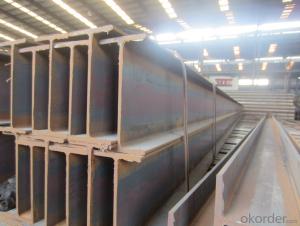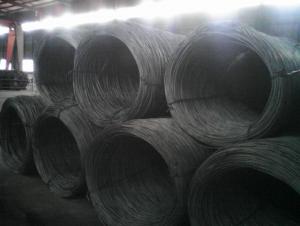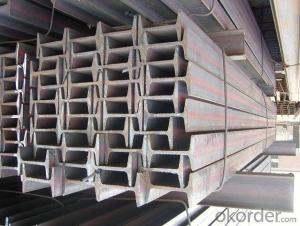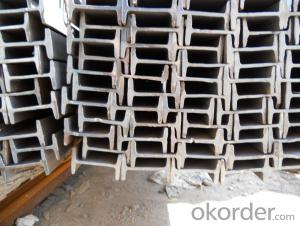Hot Rolled Structual Carbon JIS Steel H-beam Bar
- Loading Port:
- China main port
- Payment Terms:
- TT or LC
- Min Order Qty:
- 25 m.t.
- Supply Capability:
- 1000 m.t./month
OKorder Service Pledge
OKorder Financial Service
You Might Also Like
Product Description:
OKorder is offering high quality Hot Rolled Steel I-Beams at great prices with worldwide shipping. Our supplier is a world-class manufacturer of steel, with our products utilized the world over. OKorder annually supplies products to European, North American and Asian markets. We provide quotations within 24 hours of receiving an inquiry and guarantee competitive prices.
Product Applications:
Commercial building structure ;Pre-engineered buildings; Machinery support structure; Prefabricated structure; Medium scale bridges; Ship-building structure.etc.
Product Advantages:
OKorder's Steel I-Beams are durable, strong, and resist corrosion.
Main Product Features:
· Premium quality
· Prompt delivery & seaworthy packing (30 days after receiving deposit)
· Corrosion resistance
· Can be recycled and reused
· Mill test certification
· Professional Service
· Competitive pricing
Product Specifications:
Manufacture: Hot rolled
Grade: Q195 – 235
Length: 6m – 12m, as per customer request
Packaging: Export packing, nude packing, bundled
H x B
(mm)
| T1 | T2 | JIS Weight
(kg/m)
| GB Weight
(kg/m)
|
100*100 | 6 | 8 | 16.9 | 17.2 |
125*125 | 6.5 | 9 | 23.6 | 23.8 |
150*75 | 5 | 7 | 14 | 14.3 |
148*100 | 6 | 9 | 20.7 | 21.4 |
150*150 | 7 | 10 | 31.1 | 31.9 |
175*90 | 5 | 8 | 18 | 18.2 |
175*175 | 7.5 | 11 | 40.4 | 40.4 |
198*99 | 4.5 | 7 | 17.8 | 18.5 |
200*100 | 5.5 | 8 | 20.9 | 21.7 |
194*150 | 6 | 9 | 29.9 | 31.2 |
200*200 | 8 | 12 | 49.9 | 50.5 |
248*124 | 5 | 8 | 25.1 | 25.8 |
250*125 | 6 | 9 | 29 | 29.7 |
244*175 | 7 | 11 | 43.6 | 44.1 |
250*250 | 9 | 14 | 71.8 | 72.4 |
298*149 | 5.5 | 8 | 32 | 32.6 |
298*201 | 9 | 14 | 65.4 | |
300*150 | 6.5 | 9 | 36.7 | 37.3 |
294*200 | 8 | 12 | 55.8 | 57.3 |
300*300 | 10 | 15 | 93 | 94.5 |
346*174 | 6 | 9 | 41.2 | 41.8 |
350*175 | 7 | 11 | 49.4 | 50 |
340*250 | 9 | 14 | 78.1 | 79.7 |
350*350 | 12 | 19 | 135 | 137 |
400*200 | 8 | 13 | 65.4 | 66 |
390*300 | 10 | 16 | 105 | 107 |
400*400 | 13 | 21 | 172 | 172 |
446*199 | 8 | 12 | 65.1 | 66.7 |
450*200 | 9 | 14 | 77.9 | 79.5 |
440*300 | 11 | 18 | 121 | 124 |
496*199 | 9 | 14 | 77.9 | 79.5 |
500*200 | 10 | 16 | 88.2 | 89.6 |
488*300 | 11 | 18 | 125 | 129 |
596*199 | 10 | 15 | 92.5 | 95.1 |
600*200 | 11 | 17 | 103.4 | 106 |
588*300 | 12 | 20 | 147 | 151 |
700*300 | 13 | 24 | 182 | 185 |
800*300 | 14 | 26 | 207 | 210 |
900*300 | 16 | 28 | 240.1 | 243 |
Packaging & Delivery of Hot Rolled Steel H-beam For Sale
1. Packing: it is nude packed in bundles by steel wire rod
2. Bundle weight: not more than 3.5MT for bulk vessel; less than 3 MT for container load
3. Marks:
Color marking: There will be color marking on both end of the bundle for the cargo delivered by bulk vessel. That makes it easily to distinguish at the destination port.
Tag mark: there will be tag mark tied up on the bundles. The information usually including supplier logo and name, product name, made in China, shipping marks and other information request by the customer.
If loading by container the marking is not needed, but we will prepare it as customer request.
4. Transportation: the goods are delivered by truck from mill to loading port, the maximum quantity can be loaded is around 40MTs by each truck. If the order quantity cannot reach the full truck loaded, the transportation cost per ton will be little higher than full load.
5. Delivered by container or bulk vessel
FAQ:
Q1: Why buy Materials & Equipment from OKorder.com?
A1: All products offered byOKorder.com are carefully selected from China's most reliable manufacturing enterprises. Through its ISO certifications, OKorder.com adheres to the highest standards and a commitment to supply chain safety and customer satisfaction.
Q2: What makes stainless steel stainless?
A2: Stainless steel must contain at least 10.5 % chromium. It is this element that reacts with the oxygen in the air to form a complex chrome-oxide surface layer that is invisible but strong enough to prevent further oxygen from "staining" (rusting) the surface. Higher levels of chromium and the addition of other alloying elements such as nickel and molybdenum enhance this surface layer and improve the corrosion resistance of the stainless material.
Q3: Can stainless steel rust?
A3: Stainless does not "rust" as you think of regular steel rusting with a red oxide on the surface that flakes off. If you see red rust it is probably due to some iron particles that have contaminated the surface of the stainless steel and it is these iron particles that are rusting. Look at the source of the rusting and see if you can remove it from the surface.
Images:


- Q: Can steel H-beams be used for manufacturing facilities?
- Manufacturing facilities can indeed utilize steel H-beams. These beams are commonly employed in the construction industry for a range of purposes, including manufacturing facilities. With their exceptional strength, durability, and load-bearing capabilities, steel H-beams are well-suited for supporting the weight of heavy machinery, equipment, and structures within manufacturing plants. Moreover, H-beams offer a robust framework that can be easily fabricated and installed, making them an excellent option for constructing manufacturing facilities that necessitate expansive open spaces and wide spans. Furthermore, steel H-beams possess the capacity to endure high temperatures, rendering them appropriate for industries involving heat-intensive processes. In summary, steel H-beams are an adaptable and dependable choice for constructing manufacturing facilities, thanks to their structural integrity and capacity to handle substantial loads.
- Q: How do steel H-beams perform in high-traffic areas such as airports or train stations?
- Steel H-beams are an ideal choice for high-traffic areas such as airports or train stations due to their exceptional performance characteristics. Firstly, steel H-beams offer superior structural strength and stability, which is crucial in areas with heavy foot traffic and constant movement of vehicles. They can support heavy loads without bending or warping, ensuring the safety and longevity of the structure. Moreover, steel H-beams have excellent resistance to wear and tear. In high-traffic areas, frequent contact with luggage carts, trolleys, and other heavy equipment can cause significant damage to the infrastructure. However, steel H-beams are highly durable and can withstand this constant impact without compromising their structural integrity. Additionally, steel H-beams are known for their fire resistance. Airports and train stations are public spaces where fire safety is of utmost importance. Steel is a non-combustible material, and H-beams have a high melting point, which means they have a better chance of withstanding fire accidents and minimizing the spread of flames, providing added safety for occupants. Furthermore, steel H-beams are highly customizable, allowing for efficient design and construction in high-traffic areas. They can be fabricated to various lengths, sizes, and shapes, ensuring the structural requirements of the specific location are met. This versatility enables architects and engineers to create innovative and efficient designs that optimize space and accommodate the needs of the area. In terms of maintenance, steel H-beams have a low maintenance requirement, making them cost-effective in the long run. With regular inspections and minimal repairs, steel H-beams can maintain their structural integrity and appearance for many years, even in high-traffic areas. Overall, steel H-beams are the preferred choice for high-traffic areas such as airports or train stations due to their exceptional strength, durability, fire resistance, and customization options. Their performance characteristics make them capable of withstanding heavy loads, resisting wear and tear, and ensuring the safety and longevity of the infrastructure in these bustling public spaces.
- Q: Can steel H-beams be used in the construction of agricultural buildings?
- Yes, steel H-beams can be used in the construction of agricultural buildings. Steel H-beams are commonly used in construction due to their strength and durability. They provide structural support and can withstand heavy loads, making them suitable for agricultural buildings such as barns, storage facilities, or livestock shelters. Steel H-beams are also resistant to pests, rot, and fire, making them a practical choice for agricultural applications.
- Q: Are steel H-beams susceptible to warping or bending?
- Yes, steel H-beams are susceptible to warping or bending. Although steel is a strong and durable material, it is not completely immune to deformation. Depending on the specific circumstances and loads applied, H-beams can experience warping or bending. These deformations can occur due to excessive loads, improper installation, or structural design flaws. It is important to ensure proper engineering and construction practices are followed to minimize the risk of warping or bending in steel H-beams.
- Q: What are the potential drawbacks or limitations of using steel H-beams?
- There are several potential drawbacks or limitations associated with using steel H-beams in construction projects. Firstly, steel H-beams can be quite heavy and bulky, making them difficult to handle and transport. This can increase the overall cost and time required for construction projects, as specialized equipment and labor may be needed to move and position these beams. Secondly, steel H-beams are susceptible to corrosion, particularly in environments with high levels of moisture or chemicals. Without proper maintenance and protective coatings, the beams can deteriorate over time, compromising their structural integrity and durability. This can lead to safety concerns and the need for frequent inspections and repairs. Another limitation of steel H-beams is their susceptibility to fire. Steel has a relatively high melting point, but when exposed to high temperatures, it can lose its strength and structural integrity. This can result in the collapse of the building or structure, posing significant risks to occupants and neighboring properties. Additionally, steel H-beams have limited flexibility compared to other construction materials, such as wood or concrete. This can restrict the design possibilities and architectural creativity of a project, as steel beams often require specific engineering calculations and constraints. Lastly, the cost of steel H-beams can be a limiting factor for some construction projects. Steel is generally more expensive than alternative materials, and the price can fluctuate depending on market conditions and availability. This can impact the overall budget and feasibility of a project, especially for smaller-scale or budget-conscious developments. In summary, while steel H-beams offer various advantages in terms of strength and load-bearing capacity, they also come with drawbacks and limitations related to their weight, susceptibility to corrosion and fire, lack of flexibility, and higher cost. It is important for architects, engineers, and project managers to carefully consider these factors when deciding on the appropriate construction materials for their specific projects.
- Q: Are steel H-beams resistant to impact and vibration?
- Yes, steel H-beams are highly resistant to impact and vibration. The H-shape design of these beams provides great stability and strength, making them suitable for withstanding various types of external forces, including impacts and vibrations. This structural shape enables the H-beams to distribute the load evenly along the length of the beam, reducing the concentration of stress and preventing any potential damage. Additionally, steel is known for its excellent durability and toughness, which further enhances the resistance of H-beams to impact and vibration. Consequently, steel H-beams are widely used in construction, engineering, and other industries where structural stability and resistance to external forces are crucial.
- Q: In steel structures, what is the meaning of the "" between the two members of the H steel brace 2L 180*12,10?
- Specific means: double angle, angle type: L180*180*12, because the angle is equal angles, so it can be omitted in: L180*12. where: 180 refers to the angle of the width, 12 refers to the average thickness of.L boundary angle is the angle of the code before the.L 2 is Larry.
- Q: Can steel H-beams be used in the construction of residential complexes or apartments?
- Yes, steel H-beams can be used in the construction of residential complexes or apartments. Steel H-beams are strong and versatile structural components that are commonly used in construction projects. They offer several advantages over other materials such as wood or concrete. Firstly, steel H-beams have a high strength-to-weight ratio, which means they can support heavy loads while being relatively lightweight themselves. This makes them ideal for constructing large or multi-story buildings like residential complexes or apartments. Secondly, steel H-beams provide excellent durability and resistance to various environmental factors such as earthquakes, hurricanes, and termites. They have high tensile strength, which means they can withstand significant forces and deformations without breaking. Moreover, steel H-beams are highly customizable and can be fabricated to meet specific design requirements. They can be easily cut, welded, and bolted together, allowing for flexible construction designs. Additionally, steel is a sustainable and eco-friendly material. It can be recycled indefinitely without losing its inherent properties, making it an environmentally responsible choice for construction projects. In summary, steel H-beams offer numerous advantages that make them suitable for the construction of residential complexes and apartments. Their strength, durability, versatility, and sustainability make them a popular choice among architects and builders in the construction industry.
- Q: What are the specifications for H steel HW, HB, HN?
- HW is a H type steel flange height and width substantially equal; mainly used for reinforced concrete frame column steel column, also known as rigid steel column; column is mainly used in steel structure.
- Q: Can steel H-beams be used in earthquake-resistant construction?
- It is possible to use steel H-beams in earthquake-resistant construction. The reason steel is a popular choice for earthquake-resistant buildings is because of its high strength and ductility. H-beams, which are also known as I-beams or universal beams, are commonly used in construction because they have structural integrity and can bear heavy loads. When an earthquake occurs, buildings undergo dynamic forces that can cause significant stress and deformation. Steel H-beams are specifically designed to withstand these forces and are effective at resisting lateral loads and seismic movements. The shape of H-beams allows for excellent distribution of loads and provides structural stability, which is crucial in areas prone to earthquakes. Furthermore, steel has a high tensile strength, which means it can flex and absorb seismic energy without breaking or collapsing. This characteristic makes steel H-beams more resistant to earthquake-induced damage compared to other materials like wood or concrete. To further enhance earthquake resistance, H-beams can be reinforced with steel plates, braces, or other structural elements. These reinforcements help strengthen the connections between beams and columns, ultimately increasing the overall stability of the building. In summary, steel H-beams are a reliable option for earthquake-resistant construction due to their strength, ductility, and load-bearing capabilities. However, it is important to consider other factors such as proper design, construction techniques, and adherence to building codes and regulations to ensure the structure performs well during seismic events.
Send your message to us
Hot Rolled Structual Carbon JIS Steel H-beam Bar
- Loading Port:
- China main port
- Payment Terms:
- TT or LC
- Min Order Qty:
- 25 m.t.
- Supply Capability:
- 1000 m.t./month
OKorder Service Pledge
OKorder Financial Service
Similar products
Hot products
Hot Searches
Related keywords































